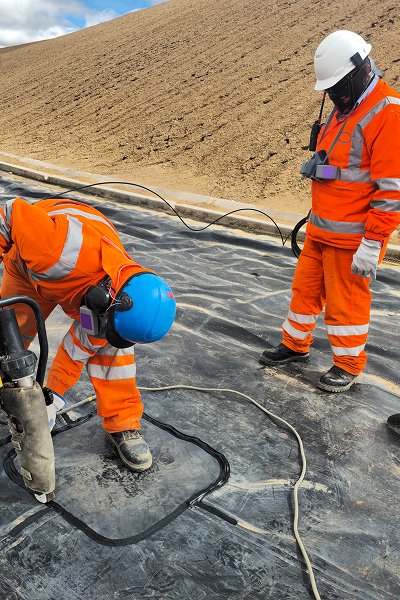Definition and function of geomembrane
Geomembrane is an anti-seepage film made of high-density polyethylene (HDPE), low-density polyethylene (LDPE), linear low-density polyethylene (LLDPE) and other polymer materials. It is widely used in the bottom and cover layer of landfills to prevent leachate and pollutants from entering groundwater or surrounding soil. The main functions of geomembranes include:
Anti-seepage effect: prevent leachate from landfills from polluting groundwater and soil.
Gas control: prevent the disorderly release of landfill gas (such as methane) and reduce greenhouse gas emissions.
Enhance structural stability: combine with other geotechnical materials to enhance the long-term stability of landfills.
Chemical corrosion resistance: effectively resist acid and alkali substances produced during the decomposition of garbage.


Characteristics of South American landfills
Climatic conditions: Tropical and subtropical regions have hotter climates and higher precipitation, which puts higher demands on the design and construction of landfills.
Differences in technical standards: There may be certain gaps in geomembrane application technology and construction quality standards in South America.
Ecological environment: The ecological environment in South America is relatively fragile, and the pollution problem of garbage seepage is particularly serious, so the use of anti-seepage geomembranes is particularly important.
Geomembrane material selection
High-density polyethylene (HDPE) geomembrane: has high impermeability, chemical resistance, UV resistance and weather resistance, and is the most commonly used material in landfill anti-seepage projects.
Linear low-density polyethylene (LLDPE) geomembrane: has better flexibility and is suitable for environments with higher requirements for crack resistance.
Polyvinyl chloride (PVC) geomembrane: has good chemical resistance, but poor UV resistance, and is suitable for landfills used for short periods of time.
Considerations for material selection
Climatic conditions: High temperatures, strong ultraviolet rays, and high precipitation require geomembranes to have excellent weather resistance and UV resistance.
Impermeability: Select geomembranes of appropriate thickness and type according to the infiltration requirements of the landfill.
Convenience of construction: The flexibility and weldability of geomembranes have a great impact on construction.
Quality control of geomembranes
Tensile strength: Ensure that the geomembrane will not be damaged by stretching during construction.
Puncture resistance: Avoid puncture damage to the geomembrane by surface objects during construction.
Thermal stability: The geomembrane should be able to adapt to high temperature environments to avoid rupture of the membrane due to thermal expansion and contraction.
Case construction display

Geomembrane laying
Laying order: According to the design requirements, the laying of geomembranes usually starts from low-lying areas and gradually lays upward along the slope. Avoid wrinkles on the membrane surface and ensure its flatness.
Diaphragm connection: The connection methods of geomembranes include heat welding, gas welding, hot air welding, etc. The temperature and pressure at the welding point must be precisely controlled to ensure the strength and sealing of the joints.
Joint treatment: The treatment of joints is crucial. Hot plate welding or electric welding is usually used to ensure that the joints are leak-proof.
Quality inspection
Diaphragm tension detection: Detect the tension of the membrane during the laying process to prevent it from being too tight or too loose.
Joint inspection: Check the joints for gaps through visual inspection and special tools to ensure that the strength of the joints meets the requirements.
Permeability test: After the geomembrane is laid, a permeability test is carried out to ensure that the anti-seepage effect of the membrane meets the standards.
Geomembrane protection
After the geomembrane is laid, in order to prevent the external environment from damaging the membrane, appropriate protection treatment should be carried out.
Covering layer construction: Cover the geomembrane with an appropriate protective layer (such as soil, sand, etc.) to avoid mechanical damage and ultraviolet radiation.
Regular inspection and maintenance: After the construction is completed, the landfill should be inspected regularly to ensure that the geomembrane is intact.
The construction of geomembranes in landfills involves multiple links, and technical specifications and construction standards must be strictly followed to ensure the anti-seepage effect. The selection of geomembrane materials, every detail in the construction process, quality control, and subsequent maintenance work all determine the stability and long-term use effect of the entire landfill anti-seepage system.


